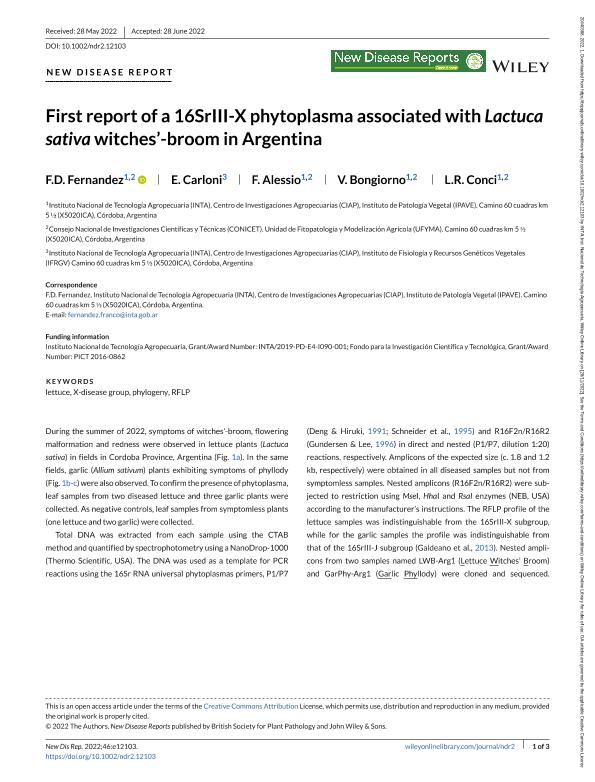Artículo
First report of a 16SrIII-X phytoplasma associated with Lactuca sativa witches’-broom in Argentina
Fernandez, Franco Daniel ; Carloni, Edgardo José; Alessio, Florencia Ivette
; Carloni, Edgardo José; Alessio, Florencia Ivette ; Bongiorno, Vanina Aylen
; Bongiorno, Vanina Aylen ; Conci, Luis Rogelio
; Conci, Luis Rogelio
 ; Carloni, Edgardo José; Alessio, Florencia Ivette
; Carloni, Edgardo José; Alessio, Florencia Ivette ; Bongiorno, Vanina Aylen
; Bongiorno, Vanina Aylen ; Conci, Luis Rogelio
; Conci, Luis Rogelio
Fecha de publicación:
25/07/2022
Editorial:
John Wiley and Sons Inc
Revista:
New Disease Reports
ISSN:
2044-0588
Idioma:
Inglés
Tipo de recurso:
Artículo publicado
Clasificación temática:
Resumen
During the summer of 2022, symptoms of witches’-broom, flowering malformation and redness were observed in lettuce plants (Lactuca sativa) in fields in Cordoba Province, Argentina (Fig. 1a). In the same fields, garlic (Allium sativum) plants exhibiting symptoms of phyllody (Fig. 1b-c) were also observed. To confirm the presence of phytoplasma, leaf samples from two diseased lettuce and three garlic plants were collected. As negative controls, leaf samples from symptomless plants (one lettuce and two garlic) were collected. Garlic decline phytoplasma (subgroup 16SrIII-J) was reported previously in association with Garlic decline disease in Argentina (Conci et al., 1998). However, this is the first time that symptoms of phyllody in garlic associated with this phytoplasma have been reported. To our knowledge, this is the first report of phytoplasmas from subgroup 16SrIII-X affecting lettuce in Argentina and worldwide. Previous work reported the presence of phytoplasmas from subgroup 16SrIII-X affecting different species of weeds in the same region (Galdeano et al., 2013; Fernández et al., 2020) which may suggest the presence of a common insect vector with polyphagous feeding behaviour.
Palabras clave:
LETTUCE
,
PHYLOGENY
,
RFLP
,
X-DISEASE GROUP
Archivos asociados
Licencia
Identificadores
Colecciones
Articulos (UFYMA)
Articulos de UNIDAD DE FITOPATOLOGIA Y MODELIZACION AGRICOLA
Articulos de UNIDAD DE FITOPATOLOGIA Y MODELIZACION AGRICOLA
Citación
Fernandez, Franco Daniel; Carloni, Edgardo José; Alessio, Florencia Ivette; Bongiorno, Vanina Aylen; Conci, Luis Rogelio; First report of a 16SrIII-X phytoplasma associated with Lactuca sativa witches’-broom in Argentina; John Wiley and Sons Inc; New Disease Reports; 46; 1; 25-7-2022; 1-3
Compartir
Altmétricas



